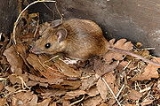
Yellow-necked mouse
Encyclopedia
The Yellow-necked Mouse Apodemus flavicollis is closely related to the wood mouse
, with which it was long confused, only being recognised as a separate species in 1894. It differs in its band of yellow
fur
around the neck
and in having slightly larger ear
s and usually being slightly larger overall. Around 100mm in length, it can climb trees
and sometimes overwinters in houses. It is found mostly in mountainous
areas of southern Europe
, but extends north into parts of Scandinavia
and Britain
. It is a critical host in the maintenance of tick-borne encephalitis. Other common names are Yellow-necked Field Mouse, Yellow-necked Wood Mouse, and South China Field Mouse.
Wood mouse
The wood mouse is a common murid rodent from Europe and northwestern Africa. It is closely related to the yellow-necked mouse but differs in that it has no band of yellow fur around the neck, has slightly smaller ears, and is usually slightly smaller overall: around 90 mm in length...
, with which it was long confused, only being recognised as a separate species in 1894. It differs in its band of yellow
Yellow
Yellow is the color evoked by light that stimulates both the L and M cone cells of the retina about equally, with no significant stimulation of the S cone cells. Light with a wavelength of 570–590 nm is yellow, as is light with a suitable mixture of red and green...
fur
Fur
Fur is a synonym for hair, used more in reference to non-human animals, usually mammals; particularly those with extensives body hair coverage. The term is sometimes used to refer to the body hair of an animal as a complete coat, also known as the "pelage". Fur is also used to refer to animal...
around the neck
Neck
The neck is the part of the body, on many terrestrial or secondarily aquatic vertebrates, that distinguishes the head from the torso or trunk. The adjective signifying "of the neck" is cervical .-Boner anatomy: The cervical spine:The cervical portion of the human spine comprises seven boney...
and in having slightly larger ear
Ear
The ear is the organ that detects sound. It not only receives sound, but also aids in balance and body position. The ear is part of the auditory system....
s and usually being slightly larger overall. Around 100mm in length, it can climb trees
Tree
A tree is a perennial woody plant. It is most often defined as a woody plant that has many secondary branches supported clear of the ground on a single main stem or trunk with clear apical dominance. A minimum height specification at maturity is cited by some authors, varying from 3 m to...
and sometimes overwinters in houses. It is found mostly in mountainous
Mountain
Image:Himalaya_annotated.jpg|thumb|right|The Himalayan mountain range with Mount Everestrect 58 14 160 49 Chomo Lonzorect 200 28 335 52 Makalurect 378 24 566 45 Mount Everestrect 188 581 920 656 Tibetan Plateaurect 250 406 340 427 Rong River...
areas of southern Europe
Europe
Europe is, by convention, one of the world's seven continents. Comprising the westernmost peninsula of Eurasia, Europe is generally 'divided' from Asia to its east by the watershed divides of the Ural and Caucasus Mountains, the Ural River, the Caspian and Black Seas, and the waterways connecting...
, but extends north into parts of Scandinavia
Scandinavia
Scandinavia is a cultural, historical and ethno-linguistic region in northern Europe that includes the three kingdoms of Denmark, Norway and Sweden, characterized by their common ethno-cultural heritage and language. Modern Norway and Sweden proper are situated on the Scandinavian Peninsula,...
and Britain
Great Britain
Great Britain or Britain is an island situated to the northwest of Continental Europe. It is the ninth largest island in the world, and the largest European island, as well as the largest of the British Isles...
. It is a critical host in the maintenance of tick-borne encephalitis. Other common names are Yellow-necked Field Mouse, Yellow-necked Wood Mouse, and South China Field Mouse.

